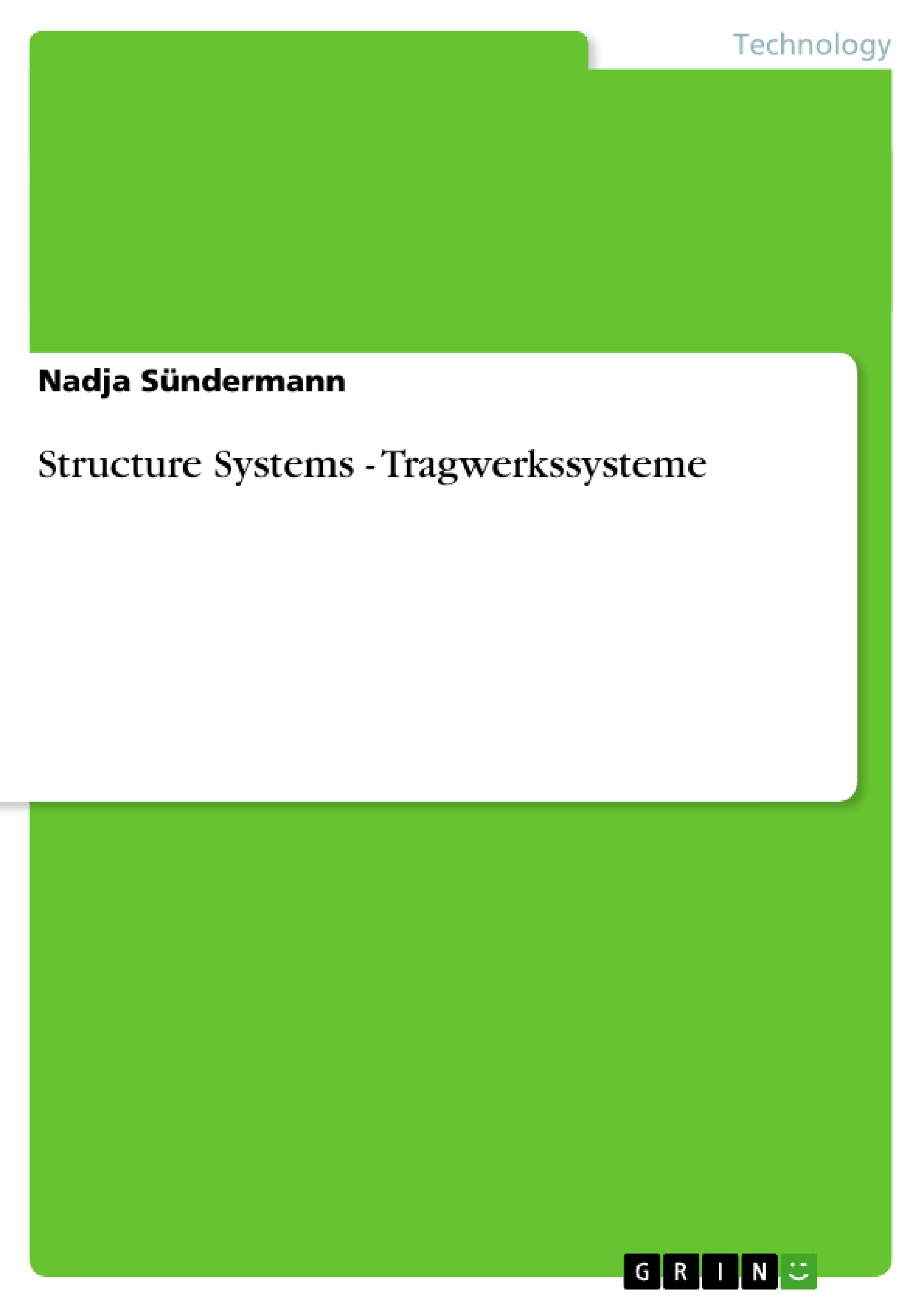List of Contents:
1. INTRUDUCTION
2. SIGNIFICANCE AND FUNCTION
3. BASICS
4. SYSTEMATICS OF STRUCTURES IN BUILDING
1. Intruduction
Hello, my name is Nadja and you know, I study civil engineering.
Because I can't present you a model I want to tell you something about SRUCTURE SYSTEMS, translated "Tragwerkssysteme".
First of all I give you a handout with vocabulary and a small summary.
Stucture Systems take the interest rating (einen interessanten Stellenwert einnehmen) to be the connection (link) between architecture and civil engineering.
Developing structure concepts is an integral component of architectural design. Hence the prevalent differentiation of structure design from architectural design is unfounded and has to be dissolved.
The problem of this claim (Anspruch) is that the subject "theory of structures" through diversity and volume has long since eluded a total comprehension (hat sich durch Vielfalt und Umfang längst dem allgemeinen Verständnis entzogen).
The whole problem, then, is twofold: The architects design buildings without any interested structural forms. The engineers cannot bring their creative potential to any architectural bearing, neither to the design of modern architecture, nor to the inventation of new prototypical structural systems.
2. Significance and Function
The significance of structure is the preservation (Bewahrung) of object functions.
For the existence of an object and of its form, it is necessary that the object can bear all forces which act on it. The consistency, that confers this capability is structure.
The structure, thus, functions in three subsequent operations:
1. Load reception (Lastaufnahme)
2. Load transfer (Lastübertragung)
3. Load discharge (Lastabgabe)
This process is called the FLOW OF FORCES (Kräfteverlauf). It is the basic image for the design of a structure.
The flow of forces does not pose problems as long as the object form follows the direction of the acting forces. A problem, however, will arise, when the flow of forces does not take a direct route.
The conclusion is this:
Knowledge of the mechanisms for directing forces in other directions is the basic condition
for developing new "pictures" of forces. The possibilities of how to redirect forces is the core of the knowledge on structures (and is the basis for a systematic in architectural structures).
3. Basics
The structure system is defined by three system components, each effecting the other. First there are the forces. These forces are determined by 4 conditions specific to each building:
- Weight of the building and its utilitarian loads
- Kind of usage
- Properties of the building substance
- Influences of the location and of its surroundings
Second there is the geometry of the building. It is the descriptive system of structural form and path of forces.
Last but not least I have to mention the MATERIAL. It is the material system that control the forces and produces geometry.
Now I want to show you a picture where you see the "The concepts in the behaviour of structures" :
You see here the diversity(Vielfalt) of forces (in structures):
Force: is a quantity which induces a solid to move or to change its state
Loads: are forces that act upon a solid from the exterior
Gravitational Force: is the force of which the mass of the earth pulls a solid.
Moment: is a turning motion
Stress: is the internal force per unit area which is mobilized in a solid through the action of an external force.
Resistance: is the force of which a solid withstands a deformation
Equilibrium: is the state in which the sum total of forces acting upon a
solid does not produce any motion
4. Systematics of Structures in building
For the redirection of acting forces (Umlenkung von angreifenden Kräften) there are 5 typical mechanisms:
For this you see the next picture:
1. Form action: The System is adjusted (angepaßt) to the forces
(Form - active structure systems are systems of flexible matter, on which the redirection of forces is effected by particular form-design and characteristic form stabilization)
2. Vektor action: The forces are dissected (aufgespaltet)
(Vector-active systems are systems of short, solid bars, in which the redirection of forces is effected by Vector partition, comprehension and tension loads arise)
3. Section action: The forces are confined (eingesperrt)
(The systems are built of rigid, solid, linear elements and mobilize sectional inner forces.)
4. Surface Action: The forces are disperced (zerstreut)
(Structures act mainly through extension and form of surface.)
5. Height Action: The loads are collected and grounded
(Structures act mainly as vertical load transmitter.)
Well, now I am at the end of my short lecture. And I hope that also the architects have taken pleasure in the theme of structure systems.
Nadja Sündermann
- Citar trabajo
- Nadja Sündermann (Autor), 2000, Structure Systems - Tragwerkssysteme, Múnich, GRIN Verlag, https://www.grin.com/document/99854




